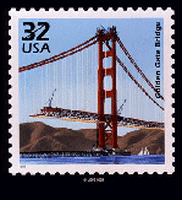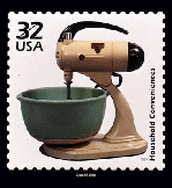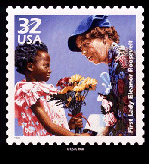Celebrate the Century: Search the Web for U.S. History of the 1930s
Superman, the legendary man of steel, returned to planet Earth on September 10, 1998, when 15 new stamps saluting the 1930s were issued by the U.S. Postal Service in Cleveland, Ohio -- where the super hero was "born."
"From the Great Depression and the New Deal programs to architectural marvels and heroes of fact and fiction, the 1930s stamps portray a time when Americans worked together to overcome great hardship in hopes of a better day," said Deputy Postmaster General Michael Coughlin, who dedicated the stamps, part of the USPS's Celebrate the Century program, at the foot of Cleveland's Terminal Tower. When it opened in June 1930, the 52-story tower was among the tallest buildings in the world. It was the tallest building west of New York for 40 years.
"From the Great Depression and the New Deal programs to architectural marvels and heroes of fact and fiction, the 1930s stamps portray a time when Americans worked together to overcome great hardship in hopes of a better day," said Deputy Postmaster General Michael Coughlin, who dedicated the stamps, part of the USPS's Celebrate the Century program, at the foot of Cleveland's Terminal Tower. When it opened in June 1930, the 52-story tower was among the tallest buildings in the world. It was the tallest building west of New York for 40 years.
The Stage is Set......
Now, it's time to hunt!! For each stamp, read the info and the question. Research to find the answer using the website. Create a document with any program you wish to record your answers.
When you finish, click on the Google Doc below, enter your information, and submit!
1930's Scavenger Hunt Form
When you finish, click on the Google Doc below, enter your information, and submit!
1930's Scavenger Hunt Form
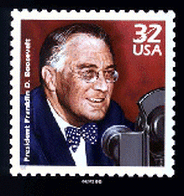
PRESIDENT FRANKLIN D. ROOSEVELT
Eight days after taking office, President Franklin D. Roosevelt made the first of his radio "fireside chats." As if speaking directly to each listener, he explained complex issues and measures being taken to deal with them. Question 1: President Roosevelt was related to a man who had served as President of the United States before him. Who was that man, and how were the two men related? Franklin D. Roosevelt Web Page
|
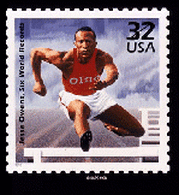
JESSE OWENS, SIX WORLD RECORDS
On the afternoon of May 25, 1935, Ohio State University's track star Jesse Owens was credited with setting five world records and tying another. The following year he earned four gold medals in international competition at Berlin.
Question 3:
When Jesse Owens was born, he wasn't named "Jesse." Nor was he named "John Cleveland" or "James Cleveland," as recorded in many biographies of the track hero. What name did Jesse's father give to him at birth?
Jesse Owns Web
On the afternoon of May 25, 1935, Ohio State University's track star Jesse Owens was credited with setting five world records and tying another. The following year he earned four gold medals in international competition at Berlin.
Question 3:
When Jesse Owens was born, he wasn't named "Jesse." Nor was he named "John Cleveland" or "James Cleveland," as recorded in many biographies of the track hero. What name did Jesse's father give to him at birth?
Jesse Owns Web
|
GOLDEN GATE BRIDGE
After more than four years of construction, the Golden Gate Bridge opened to vehicular traffic May 28, 1937. Boasting a 4,200-foot-long main span, the "International Orange" bridge carried the moderate price tag of $35 million. Question 4: The designer of the Golden Gate Bridge worked many hours to convince citizens that the bridge could be built and that it could pay for itself with tolls paid by travelers. Who was that famous bridge designer? Golden Gate Bridge Web |
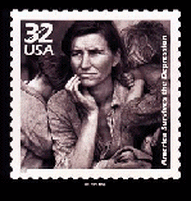
AMERICA SURVIVES THE DEPRESSION
Dorothea Lange's 1936 photograph of Native American Florence Owens Thompson symbolizes the courage of Americans as they tried to survive the hard times of the Great Depression.
Question 5:
During the Depression years, people who were lucky enough to have jobs were paid very low wages. About how much was an accountant paid each week during the Depression? About how much is an accountant paid each week today?
Then and Now: Prices
Dorothea Lange's 1936 photograph of Native American Florence Owens Thompson symbolizes the courage of Americans as they tried to survive the hard times of the Great Depression.
Question 5:
During the Depression years, people who were lucky enough to have jobs were paid very low wages. About how much was an accountant paid each week during the Depression? About how much is an accountant paid each week today?
Then and Now: Prices
|
THE MONOPOLY GAME
Produced commercially for the first time in 1933, the Monopoly game became the world's most famous board game. In a period of economic depression, players enjoyed amassing fortunes and driving opponents bankrupt. Question 6: Most of the places on the Monopoly board game were named by the game's inventor for places in a real U.S. city. What city is that? Monopoly Story Page |
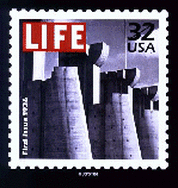
FIRST LIFE ISSUE 1936
Established in November 1936, LIFE magazine opened a new era of photojournalism. With limited text, and photographs on almost every page, it expanded our awareness of current events and the human race.
Question 7:
What was pictured on the cover of the very first issue of LIFE magazine, on November 23, 1936?
Life Magazine History Page
Established in November 1936, LIFE magazine opened a new era of photojournalism. With limited text, and photographs on almost every page, it expanded our awareness of current events and the human race.
Question 7:
What was pictured on the cover of the very first issue of LIFE magazine, on November 23, 1936?
Life Magazine History Page
|
HOUSEHOLD CONVENIENCES
Showing faith in new technology, household purchases focused on electric mixers, refrigerators, vacuum cleaners, irons, and pop-up toasters. The 1930s also saw the spread of sliced bread and packaged frozen foods. Question 8: The pop-up toaster was one of the household conveniences that became commonplace in kitchens across America in the 1930s. "This amazing new invention makes perfect toast every time!" proclaimed ads in the Saturday Evening Post. "Without turning! Without burning!" The pop-up toaster was invented some years before it became popular. In what year was it invented, and by whom? Toaster Museum Web |
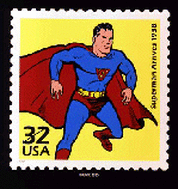
SUPERMAN ARRIVES 1938
Created by Jerry Siegel and Joe Shuster, Superman first appeared in 1938. The Man of Steel was the world's first comic book super hero. His sensational powers and dynamic deeds changed forever the content and style of the comic book.
Question 9:
How much money were Siegel and Shuster paid for each page of their first Superman comic book?
The Big Red S Web
Superman History
Created by Jerry Siegel and Joe Shuster, Superman first appeared in 1938. The Man of Steel was the world's first comic book super hero. His sensational powers and dynamic deeds changed forever the content and style of the comic book.
Question 9:
How much money were Siegel and Shuster paid for each page of their first Superman comic book?
The Big Red S Web
Superman History
|
FIRST LADY ELEANOR ROOSEVELT
Eleanor Roosevelt was an extremely vocal, active, and influential First Lady. During press conferences for women reporters and in her syndicated column, she championed the rights of women, youths, minorities, and the disadvantaged. Question 10: Unlike First Ladies before her, Eleanor Roosevelt spoke her opinions freely in lectures, radio broadcasts, and in a daily newspaper column. What was her newspaper column called? Roosevelt Web |


